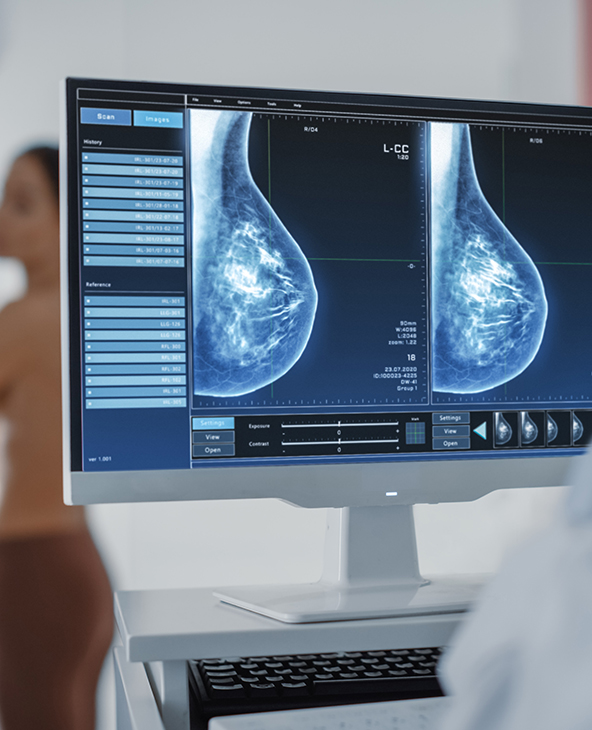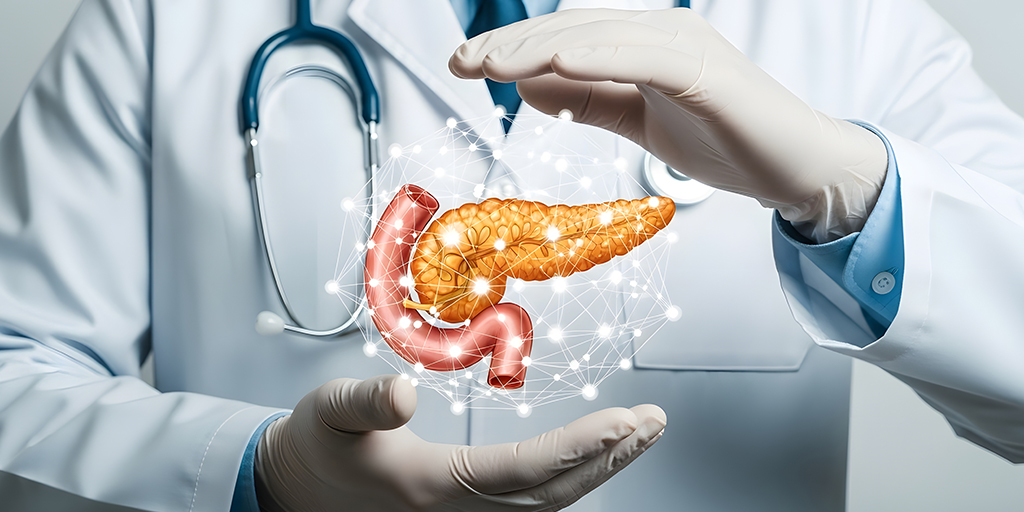Breast cancer is the most common cancer among women in India, with cases continuing to rise in both urban and rural areas. Although advances in medical science have improved survival rates, timely and accurate diagnosis remains the most critical factor for better outcomes. At Graphic Era Hospital, Dehradun, we provide comprehensive breast cancer treatment supported by advanced diagnostic tools such as mammogram tests, biopsies, and imaging, along with a full range of surgical and medical therapies. Our Department of Surgical Oncology specialises in breast-conserving surgeries, mastectomy, oncoplastic techniques, and breast reconstruction, ensuring both effective cancer removal and improved quality of life. In collaboration with the Department of Obstetrics & Gynaecology, we also emphasise preventive screening for cervical and breast cancer to detect disease at the earliest stage.
What is Breast Cancer?
Breast cancer occurs when cells in the breast begin to grow abnormally and multiply in an uncontrolled way, forming a lump or tumour. Over time, these cancer cells may invade nearby tissues or spread to other parts of the body through the blood and lymphatic system.

Although breast cancer is most common in women, it can also affect men, though in men it is a rare occurrence and accounts for only about 1% of all diagnosed cases. In both men and women, the disease can affect one or both breasts and may present as a lump, changes in breast size or shape, or alterations in the skin and nipples.
At its earliest stages, breast cancer may not cause any obvious symptoms, which is why regular breast cancer screening through mammograms and clinical exams is crucial for early detection. When identified early, treatment is often more effective, and outcomes are significantly improved.
Types of Breast Cancer
Breast cancer is not a single disease but has different forms, each with its own behaviour and treatment approach. Understanding the type of breast cancer helps doctors create the most effective treatment plan.
The main types include:
- Invasive (infiltrating) ductal carcinoma (IDC): The most common type, starting in the milk ducts and spreading to nearby breast tissue.
- Lobular breast cancer: Begins in the milk-producing glands (lobules) and can spread to surrounding tissue.
- Ductal carcinoma in situ (DCIS): A non-invasive form where abnormal cells are found inside the ducts but have not spread; considered an early stage of breast cancer.
- Triple-negative breast cancer (TNBC): An aggressive type that does not respond to hormone therapy or HER2-targeted treatments, requiring chemotherapy or advanced therapies.
- Inflammatory breast cancer (IBC): A rare but fast-growing form that blocks lymph vessels in the skin, causing redness, swelling, and warmth.
- Paget’s disease of the breast: A rare cancer affecting the skin of the nipple and areola, often associated with underlying breast cancer.
Symptoms and Diagnosis of Breast Cancer
Recognising the signs of breast cancer early and undergoing timely diagnosis can make a significant difference in treatment outcomes. At Graphic Era Hospital, we combine advanced imaging with expert clinical evaluation to ensure accurate and early detection.
Common symptoms of breast cancer include:
- Lump in the breast or underarm: Often painless and firm, but any new lump should be checked.
- Changes in breast shape or size: Noticeable swelling or shrinkage in one breast.
- Skin dimpling or redness: The skin may look puckered, thickened, or inflamed.
- Nipple discharge or retraction: Fluid other than breast milk or the nipple turning inward.
- Persistent breast pain: Ongoing discomfort not linked to the menstrual cycle.
Diagnostic methods used include:
- Clinical breast exam: A physical examination by a doctor to check for lumps or changes.
- Mammogram test: An X-ray of the breast to detect early or hidden cancers.
- MRI and ultrasound: Imaging techniques to provide detailed pictures of breast tissue.
- Biopsy: A small sample of breast tissue is taken and examined under a microscope to confirm diagnosis.
Stages of Breast Cancer
Staging describes how far breast cancer has developed at the time of diagnosis. It helps doctors plan treatment and predict outcomes. The staging system often uses the TNM method (Tumour size, lymph Node involvement, and Metastasis, or spread).
The main stages include:
- Stage 0: Also called carcinoma in situ, at this stage the abnormal cells are present in the breast but have not spread beyond the ducts or lobules.
- Stage I: At this stage, the tumour is small (up to 2 cm) and may have spread slightly to nearby lymph nodes.
- Stage II: The tumour is larger (2–5 cm) or may have spread to a few nearby lymph nodes.
- Stage III: This is a more advanced stage where the tumour is larger or has spread to many lymph nodes and possibly chest wall or skin.
- Stage IV: Also called metastatic breast cancer, this stage occurs when the disease has spread beyond the breast and nearby lymph nodes to distant organs such as the lungs, liver, bones, or brain.
Treatment Options for Breast Cancer at Graphic Era Hospital
At Graphic Era Hospital, breast cancer treatment is personalised to each patient’s stage, type, and overall health. Our Department of Surgical Oncology works closely with medical and radiation oncologists to provide complete, multidisciplinary care.
The main treatment options include:
- Mastectomy: Surgical removal of the whole breast, often recommended for larger tumours or advanced disease.
- Lumpectomy (breast-conserving surgery): Removal of only the cancerous lump and a small margin of surrounding tissue, preserving most of the breast.
- Oncoplastic surgery and breast reconstruction: Techniques to restore the natural appearance of the breast after cancer removal, using implants or the patient’s own tissue.
- Chemotherapy for breast cancer: Use of strong medicines to destroy cancer cells, often given before or after surgery.
- Radiation therapy: High-energy beams targeted at the breast to kill remaining cancer cells after surgery.
- Hormone therapy: Treatment for hormone-sensitive cancers to block or lower hormones that fuel growth.
- Targeted therapy: Medicines designed to attack specific cancer cell markers such as HER2.
- Immunotherapy: Boosts the body’s immune system to fight certain aggressive types of breast cancer.
Why Choose Graphic Era Hospital for Breast Cancer Treatment in Dehradun?

Causes and Risk Factors of Breast Cancer
The exact cause of breast cancer is not always known, but certain factors can increase the risk of developing the disease. Understanding these risks can help with prevention, early screening, and timely medical care.
Common causes and risk factors include:
- Family history and genetic factors (BRCA mutations): Women and men with inherited BRCA1 or BRCA2 gene mutations have a higher chance of developing breast cancer.
- Age and gender: The risk increases with age, and women are more commonly affected, though breast cancer in men is also possible.
- Hormonal factors: Early menstruation, late menopause, or long-term hormone replacement therapy can increase risk due to prolonged hormone exposure.
- Lifestyle factors: Obesity, alcohol use, smoking, and a lack of physical activity can raise the likelihood of developing breast cancer.
- Radiation exposure: Previous radiation treatment to the chest area, especially at a young age, may contribute to breast cancer later in life.
Top Breast Cancer Treatments at Graphic Era Hospital
- Mastectomy
- Lumpectomy (Breast-Conserving Surgery)
- Oncoplastic Breast Surgery and Reconstruction
- Chemotherapy
- Radiation Therapy
- Hormone Therapy
- Targeted Therapy
- Immunotherapy
Blog
Frequently Asked Questions
What are the early signs of breast cancer?
Early signs may include a lump in the breast or underarm, changes in breast size or shape, skin dimpling, nipple discharge, or persistent breast pain. That is why awareness of breast cancer is essential, as a mammogram test can detect cancers even before symptoms appear.
Is every breast lump cancerous?
No, not all breast lumps are cancer. Some may be benign conditions such as cysts or fibroadenomas. However, any new lump should be examined by a doctor to rule out cancer.
What are the stages of breast cancer?
Breast cancer stages range from Stage 0 (non-invasive) to Stage IV (metastatic). The stage depends on tumour size, lymph node involvement, and whether the cancer has spread to other organs.
Can breast cancer be treated without surgery?
Some cases may be managed with treatments such as chemotherapy, hormone therapy, targeted therapy, or immunotherapy, but surgery is often part of the treatment plan, especially for solid tumours.
What are the side effects of breast cancer treatment?
Side effects vary but may include hair loss, nausea, fatigue, appetite changes, mouth sores, or skin changes. These are usually temporary and managed with supportive care.
Can men also develop breast cancer?
Yes, breast cancer in men is possible, though less common. Symptoms are similar, such as lumps or nipple changes, and early detection is equally important.
Is breast cancer hereditary?
Breast cancer can run in families, particularly with BRCA1 or BRCA2 gene mutations. Genetic testing and counselling can help assess risk in such cases.
Where can I get a mammogram test near me in Dehradun?
Graphic Era Hospital in Dehradun offers mammogram and advanced breast cancer screening services as part of its women’s health and oncology care.
Which is the best hospital for breast cancer treatment in Uttarakhand?
Graphic Era Hospital is recognised for providing advanced breast cancer treatment in Uttarakhand, combining surgical oncology expertise, modern therapies, and long-term rehabilitation care.






